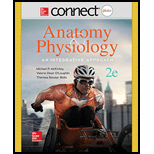
Concept explainers
Introduction:
Lymphatic system comprises of cells, tissues and other organs which defend our body against infections and disease. It is also comprised of lymph-a clear fluid which is found outside the cells. Lymphatic system has lymphatic capillaries, vessels, ducts, and trunks. Lymphatic system is also comprised of lymphatic tissues or organs like, tonsils, lymph nodes and nodules, spleen, and MALT.
Answer to Problem 1DYKB
Correct answer:
The lymphatic system is a part of the circulatory system and immune system that have interconnected lymphatic vessels which contain a clear fluid called lymph. Therefore, option b. is correct.
Explanation of Solution
Reason for the correct statement:
Option b. is given as “cardiovascular and immune”. The circulatory and immune systems are supported by the lymphatic system. The lymphatic fluid is consists of immune system cells that protect against infection and also the circulatory fluid blood is filtered by the spleen. Hence, immune and cardiovascular systems are the body systems which are supported by the lymphatic system.
Hence, option b. is correct.
Reasons for the incorrect statements:
Option a. is given as “cardiovascular and urinary”. Lymphatic system supports cardiovascular system but does not have any role with the urinary system. Hence, option a. is incorrect.
Option c. is given as “respiratory and cardiovascular”. Lymphatic system supports cardiovascular system but it does not supports the respiratory system. Hence, option c. is incorrect.
Option d. is given as “respiratory and urinary”. Lymphatic system supports circulatory and immune systems in body but does not have any function in either respiratory or urinary system. Hence, option d. is incorrect.
Hence, options a., c., and d. are incorrect.
Lymphatic system supports both circulatory and immune systems as they are interconnected. Lymphatic system provides immunity to cells, tissues and other organs which helps to defend the body against infections and disease. Lymphatic system also returns the fluid leaked from the blood back into the circulation.
Want to see more full solutions like this?
Chapter 21 Solutions
Connect Access Card for Anatomy & Physiology
- Molecular Biology Question Please help. Thank you Explain what is meant by the term “defective virus.” Explain how a defective virus is able to replicate.arrow_forwardMolecular Biology Explain why changing the codon GGG to GGA should not be harmful. Please help . Thank youarrow_forwardStage Percent Time in Hours Interphase .60 14.4 Prophase .20 4.8 Metaphase .10 2.4 Anaphase .06 1.44 Telophase .03 .72 Cytukinesis .01 .24 Can you summarize the results in the chart and explain which phases are faster and why the slower ones are slow?arrow_forward
- Can you circle a cell in the different stages of mitosis? 1.prophase 2.metaphase 3.anaphase 4.telophase 5.cytokinesisarrow_forwardWhich microbe does not live part of its lifecycle outside humans? A. Toxoplasma gondii B. Cytomegalovirus C. Francisella tularensis D. Plasmodium falciparum explain your answer thoroughly.arrow_forwardSelect all of the following that the ablation (knockout) or ectopoic expression (gain of function) of Hox can contribute to. Another set of wings in the fruit fly, duplication of fingernails, ectopic ears in mice, excess feathers in duck/quail chimeras, and homeosis of segment 2 to jaw in Hox2a mutantsarrow_forward
- Select all of the following that changes in the MC1R gene can lead to: Changes in spots/stripes in lizards, changes in coat coloration in mice, ectopic ear formation in Siberian hamsters, and red hair in humansarrow_forwardPleiotropic genes are genes that (blank) Cause a swapping of organs/structures, are the result of duplicated sets of chromosomes, never produce protein products, and have more than one purpose/functionarrow_forwardA loss of function mutation in Pitx1 enhancers can cause (blank) Removal of Pitx1 exons and growth of ectopic hindlimbs, growth of extra ectopic forelimbs, loss of forelimb specification and development, and loss of hindlimb specification and developmentarrow_forward
- Hox1a most likely contributes to (blank) patterning in the developing embryo? Ventral, posterior, limb or anteriorarrow_forwardSelect all of the following that can help establish Hox gene expression boundaries (things that affect Hox and not things that Hox affects). Retinoic acid, anterior/posterior axis, fibroblast growth factors, vagal neural crest, and enhancersarrow_forwardEctopic expression of Hox often results in (blank) phenotypes. (Blank) transformations are characterized by the replacement of one body part/structure with another. Hoxeotic, homealoneotic, joexotic, or homeoticarrow_forward
 Biology (MindTap Course List)BiologyISBN:9781337392938Author:Eldra Solomon, Charles Martin, Diana W. Martin, Linda R. BergPublisher:Cengage Learning
Biology (MindTap Course List)BiologyISBN:9781337392938Author:Eldra Solomon, Charles Martin, Diana W. Martin, Linda R. BergPublisher:Cengage Learning Medical Terminology for Health Professions, Spira...Health & NutritionISBN:9781305634350Author:Ann Ehrlich, Carol L. Schroeder, Laura Ehrlich, Katrina A. SchroederPublisher:Cengage Learning
Medical Terminology for Health Professions, Spira...Health & NutritionISBN:9781305634350Author:Ann Ehrlich, Carol L. Schroeder, Laura Ehrlich, Katrina A. SchroederPublisher:Cengage Learning Concepts of BiologyBiologyISBN:9781938168116Author:Samantha Fowler, Rebecca Roush, James WisePublisher:OpenStax College
Concepts of BiologyBiologyISBN:9781938168116Author:Samantha Fowler, Rebecca Roush, James WisePublisher:OpenStax College





